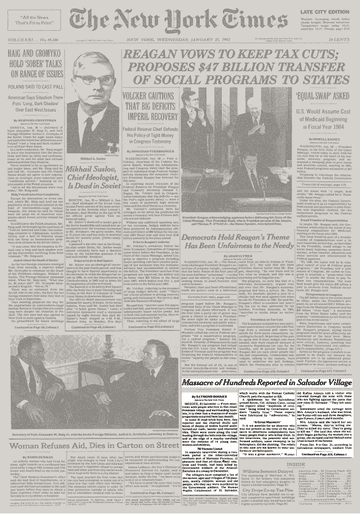
Credits: Bonner, Raymond. “Massacre of Hundreds Reported in Salvador Village”. New York Times. Jan. 27, 1982.
Introduction
On January 3, 1982, Raymond Bonner and Susan Meiselas traveled to El Salvador to investigate allegations that a massacre had occurred in northern El Morazán. At the time, Bonner was working as an investigative journalist and foreign correspondent for the New York Times. Meiselas (an American photographer) had already been working in Central America documenting the Nicaraguan Revolution. Bonner and Meiselas had been invited to come to El Salvador by the FMLN who wanted to show the world the human rights violations committed by the Salvadoran Army. In his article, Bonner concludes that a massacre had occurred in El Mozote providing descriptions of the evidence he found including human remains, burned homes, and discarded weapons. Bonner states the estimated number of casualties and places special emphasis on the fact that around half of the bodies found were children under the age of twelve. Throughout his article, Bonner tries to remain neutral to provide an unbiased account of his visit to El Mozote. Bonner even makes the disclaimer that “It is not possible for an observer who was not present at the time of the massacre to determine independently how many people died or who killed them” (Bonner 1982). Yet, Bonner does mention specific material evidence such as the leftover bullets suggesting that the Salvadoran Army carried out the massacre.
Bonner along with journalist Alma Guillermoprieto (then reporting for The Washington Post) are credited with breaking the news of the massacre in the United States. Although Bonner traveled to El Salvador a week before Guillermoprieto, they both agreed to release e their articles on the same day. On January 27th, 1982, the New York Times and the Washington Post published front-page articles on the massacre. These articles came out the day before Ronald Reagan planned to release a public statement on the Salvadoran Army’s progress in respecting people’s human rights. The US general public was angered by the news of the alleged massacre and demanded action by the US government. In response, the US government began its own investigation. . After completing its investigation, the US government completely denied that a massacre had occurred in northern Morazón. Additionally, the US government attempted to discredit Banner by arguing that his entire article was speculation and filled with embellishments from FLMN supporters. Amidst the rising controversy surrounding news of a massacre, the New York Times pulled Bonner from El Salvador in 1982 and reassigned him to the business sector of the newspaper. While the New York Times dismissed allegations that Bonner’s removal from El Salvador was in response to pressure from the Reason Administration, the newspaper’s allegation still sent a clear message to other journalists reporting on US involvement in Central America. Reporters learned that they needed to be careful with what they said about the Reason Administration if they wanted to keep their jobs.
Source Excerpts
“From interviews with people who live in this small mountain village and surrounding hamlets, it is clear that a massacre of major proportions occurred here last month.”
“In separate interviews during a two-week period in the rebel-controlled northern part of Morazan Province, 13 peasants said that all these, their relatives and friends, had been killed by Government soldiers of the Atlacatl Battalion in a sweep in December. 733 Victims Listed”
Link to Full Article: https://www.nytimes.com/1982/01/27/world/massacre-of-hundreds-reported-in-salvador-village.html?searchResultPosition=1
Bonner, Raymond. “Massacre of Hundreds Reported in Salvador Village”. New York Times. Jan. 27, 1982.